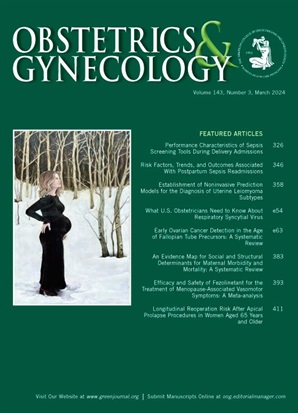Artificial Intelligence for the Detection of Fetal Ultrasound Findings Concerning for Major Congenital Heart Defects.
IF 4.7
2区 医学
Q1 OBSTETRICS & GYNECOLOGY
引用次数: 0
Abstract
OBJECTIVE To evaluate the performance of an artificial intelligence (AI)-based software to identify second-trimester fetal ultrasound examinations suspicious for congenital heart defects. METHODS The software analyzes all grayscale two-dimensional ultrasound cine clips of an examination to evaluate eight morphologic findings associated with severe congenital heart defects. A data set of 877 examinations was retrospectively collected from 11 centers. The presence of suspicious findings was determined by a panel of expert pediatric cardiologists, who determined that 311 examinations had at least one of the eight suspicious findings. The AI software processed each examination, labeling each finding as present, absent, or inconclusive. RESULTS Of the 280 examinations with known severe congenital heart defects, 278 (sensitivity 0.993, 95% CI, 0.974-0.998) had at least one of the eight suspicious findings present as determined by the fetal cardiologists, highlighting the relevance of these eight findings. We then evaluated the performance of the AI software, which identified at least one finding as present in 271 examinations, that all eight findings were absent in five examinations, and was inconclusive in four of the 280 examinations with severe congenital heart defects, yielding a sensitivity of 0.968 (95% CI, 0.940-0.983) for severe congenital heart defects. When comparing the AI to the determination of findings by fetal cardiologists, the detection of any finding by the AI had a sensitivity of 0.987 (95% CI, 0.967-0.995) and a specificity of 0.977 (95% CI, 0.961-0.986) after exclusion of inconclusive examinations. The AI rendered a decision for any finding (either present or absent) in 98.7% of examinations. CONCLUSION The AI-based software demonstrated high accuracy in identification of suspicious findings associated with severe congenital heart defects, yielding a high sensitivity for detecting severe congenital heart defects. These results show that AI has potential to improve antenatal congenital heart defect detection.人工智能在重大先天性心脏缺陷胎儿超声检查中的应用。
目的评价基于人工智能(AI)的软件识别妊娠中期胎儿超声检查疑似先天性心脏缺陷的性能。方法该软件分析了一项检查的所有灰度二维超声电影片段,以评估与严重先天性心脏缺陷相关的8种形态学表现。回顾性收集了11个中心的877例检查数据。可疑发现的存在是由一个儿科心脏病专家小组确定的,他们确定311项检查至少有8项可疑发现中的一项。人工智能软件处理每次检查,将每个发现标记为存在、缺失或不确定。结果在280例已知严重先天性心脏缺陷的检查中,278例(敏感性0.993,95% CI 0.974-0.998)至少存在由胎儿心脏病专家确定的8项可疑发现中的一项,突出了这8项发现的相关性。然后,我们评估了人工智能软件的性能,该软件在271次检查中至少发现了一项发现,在5次检查中没有发现所有8项发现,并且在280次检查中有4次对严重先天性心脏缺陷不确定,对严重先天性心脏缺陷的敏感性为0.968 (95% CI, 0.940-0.983)。将人工智能与胎儿心脏病专家的诊断结果进行比较,在排除不确定的检查后,人工智能对任何发现的检测灵敏度为0.987 (95% CI, 0.967-0.995),特异性为0.977 (95% CI, 0.961-0.986)。在98.7%的检查中,人工智能对任何发现(无论是存在还是缺席)做出了决定。结论基于人工智能的软件对严重先天性心脏缺陷可疑表现的识别准确率较高,对严重先天性心脏缺陷的检测具有较高的敏感性。这些结果表明,人工智能具有提高产前先天性心脏缺陷检测的潜力。
本文章由计算机程序翻译,如有差异,请以英文原文为准。
求助全文
约1分钟内获得全文
求助全文
来源期刊

Obstetrics and gynecology
医学-妇产科学
CiteScore
11.10
自引率
4.20%
发文量
867
审稿时长
1 months
期刊介绍:
"Obstetrics & Gynecology," affectionately known as "The Green Journal," is the official publication of the American College of Obstetricians and Gynecologists (ACOG). Since its inception in 1953, the journal has been dedicated to advancing the clinical practice of obstetrics and gynecology, as well as related fields. The journal's mission is to promote excellence in these areas by publishing a diverse range of articles that cover translational and clinical topics.
"Obstetrics & Gynecology" provides a platform for the dissemination of evidence-based research, clinical guidelines, and expert opinions that are essential for the continuous improvement of women's health care. The journal's content is designed to inform and educate obstetricians, gynecologists, and other healthcare professionals, ensuring that they stay abreast of the latest developments and best practices in their field.
 求助内容:
求助内容: 应助结果提醒方式:
应助结果提醒方式:


